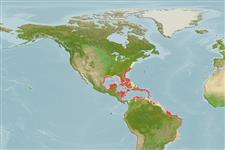Common names from other countries
Environment: milieu / climate zone / depth range / distribution range
Ecologia
marinhas associadas(os) a recifes; intervalo de profundidade 3 - 70 m (Ref. 13121), usually 5 - 20 m (Ref. 13121). Tropical; 41°N - 29°S, 100°W - 28°W (Ref. 55200)
Western Atlantic: Massachusetts, USA to Santa Catarina, Brazil (Ref. 57756), including the Gulf of Mexico and Caribbean Sea. Eastern Central Atlantic: St. Paul's Rocks (Ref. 13121).
Comprimento de primeira maturação / Tamanho / Peso / Idade
Maturity: Lm 12.4 range ? - ? cm
Max length : 16.0 cm TL macho/indeterminado; (Ref. 9710)
Espinhos dorsais (total) : 12; Raios dorsais (total) : 19 - 21; Espinhos anais: 3; Raios anais : 16 - 17. With two broad black bars on side of body and a third bar basally in soft portion of dorsal fin which extends onto caudal peduncle; broad black submarginal bands in the median fins; pelvic fins black except for the spine (Ref. 13442).
Maximum depth from Ref. 126840. Inhabit coral reefs. Occur singly or in pairs. Feed on polychaete worms, coral polyps, crustaceans and mollusk eggs. Oviparous (Ref. 205), monogamous (Ref. 52884). Form pairs during breeding (Ref. 205). Adults may form plankton-feeding aggregations of up to 20 individuals, and occasionally clean other reef fishes which join the group, such as grunts, parrotfishes and surgeon fishes. (Ref: 40093). Generally common (Ref. 9710).
Ciclo de vida ou comportamento de acasalamento
Maturities | Reprodução | Spawnings | Egg(s) | Fecundities | Larvas
Distinct pairing (Ref. 205). Monogamous mating is observed as both obligate and social (Ref. 52884).
Allen, G.R., 1985. Butterfly and angelfishes of the world. Vol. 2. 3rd edit. in English. Mergus Publishers, Melle, Germany. (Ref. 4858)
Status na Lista Vermelha da UICN (Ref. 130435)
CITES (Ref. 128078)
Not Evaluated
Ameaça para os humanos
Harmless
Uso pelos humanos
Pescarias: espécies comerciais; Aquário: Espécies comerciais
Ferramentas
Relatórios especiais
Baixar XML
Fontes da internet
Estimates based on models
Preferred temperature (Ref.
115969): 25 - 28, mean 27.2 (based on 158 cells).
Índice de diversidade filogenética (Ref.
82804): PD
50 = 0.5000 [Uniqueness, from 0.5 = low to 2.0 = high].
Bayesian length-weight: a=0.02239 (0.01442 - 0.03475), b=3.02 (2.89 - 3.15), in cm Total Length, based on LWR estimates for this species & Genus-body shape (Ref.
93245).
Nível Trófico (Ref.
69278): 3.5 ±0.2 se; based on diet studies.
Resiliência (Ref.
120179): Elevada, tempo mínimo de duplicação da população menor que 15 meses (Preliminary K or Fecundity.).
Fishing Vulnerability (Ref.
59153): Low vulnerability (10 of 100).
